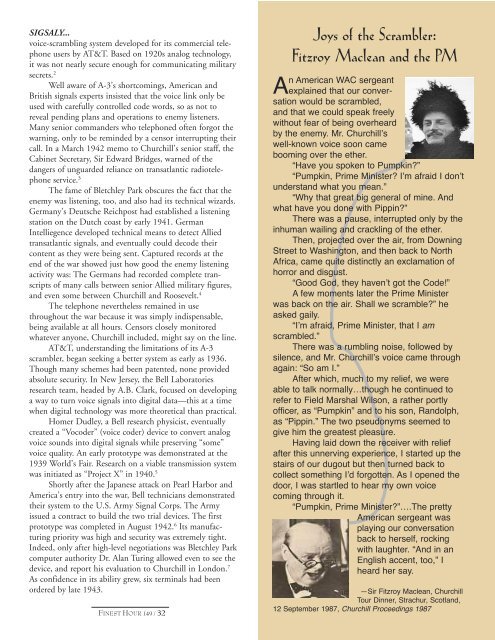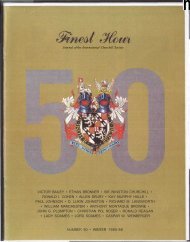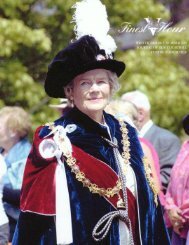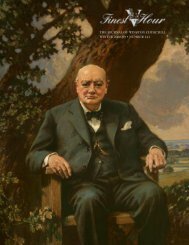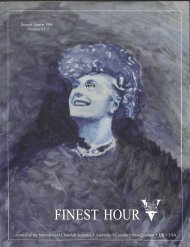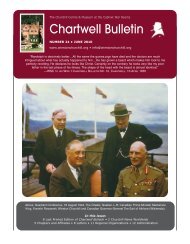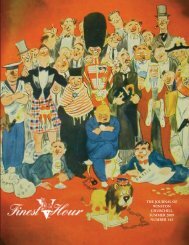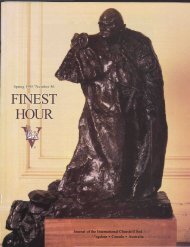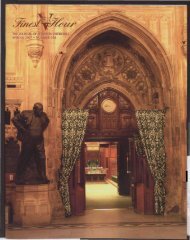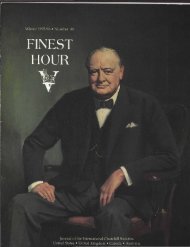SIGSALY...voice-scrambling system developed for its commercial telephoneusers by AT&T. Based on 1920s analog technology,it was not nearly secure enough for communicating militarysecrets. 2Well aware of A-3’s shortcomings, American andBritish signals experts insisted that the voice link only beused with carefully controlled code words, so as not toreveal pending plans and operations to enemy listeners.Many senior commanders who telephoned often forgot thewarning, only to be reminded by a censor interrupting theircall. In a March 1942 memo to <strong>Churchill</strong>’s senior staff, theCabinet Secretary, Sir Edward Bridges, warned of thedangers of unguarded reliance on transatlantic radiotelephoneservice. 3The fame of Bletchley Park obscures the fact that theenemy was listening, too, and also had its technical wizards.Germany’s Deutsche Reichpost had established a listeningstation on the Dutch coast by early 1941. GermanIntelliegence developed technical means to detect Alliedtransatlantic signals, and eventually could decode theircontent as they were being sent. Captured records at theend of the war showed just how good the enemy listeningactivity was: The Germans had recorded complete transcriptsof many calls between senior Allied military figures,and even some between <strong>Churchill</strong> and Roosevelt. 4The telephone nevertheless remained in usethroughout the war because it was simply indispensable,being available at all hours. Censors closely monitoredwhatever anyone, <strong>Churchill</strong> included, might say on the line.AT&T, understanding the limitations of its A-3scrambler, began seeking a better system as early as 1936.Though many schemes had been patented, none providedabsolute security. In New Jersey, the Bell Laboratoriesresearch team, headed by A.B. Clark, focused on developinga way to turn voice signals into digital data—this at a timewhen digital technology was more theoretical than practical.Homer Dudley, a Bell research physicist, eventuallycreated a “Vocoder” (voice coder) device to convert analogvoice sounds into digital signals while preserving “some”voice quality. An early prototype was demonstrated at the1939 World’s Fair. Research on a viable transmission systemwas initiated as “Project X” in 1940. 5Shortly after the Japanese attack on Pearl Harbor andAmerica’s entry into the war, Bell technicians demonstratedtheir system to the U.S. Army Signal Corps. The Armyissued a contract to build the two trial devices. The firstprototype was completed in August 1942. 6 Its manufacturingpriority was high and security was extremely tight.Indeed, only after high-level negotiations was Bletchley Parkcomputer authority Dr. Alan Turing allowed even to see thedevice, and report his evaluation to <strong>Churchill</strong> in London. 7As confidence in its ability grew, six terminals had beenordered by late 1943.FINEST HOUR 149 / 32Joys of the Scrambler:Fitzroy Maclean and the PMAn American WAC sergeantexplained that our conversationwould be scrambled,and that we could speak freelywithout fear of being overheardby the enemy. Mr. <strong>Churchill</strong>’swell-known voice soon camebooming over the ether.“Have you spoken to Pumpkin?”“Pumpkin, Prime Minister? I’m afraid I don’tunderstand what you mean.”“Why that great big general of mine. Andwhat have you done with Pippin?”There was a pause, interrupted only by theinhuman wailing and crackling of the ether.Then, projected over the air, from DowningStreet to Washington, and then back to NorthAfrica, came quite distinctly an exclamation ofhorror and disgust.“Good God, they haven’t got the Code!”A few moments later the Prime Ministerwas back on the air. Shall we scramble?” heasked gaily.“I’m afraid, Prime Minister, that I amscrambled.”There was a rumbling noise, followed bysilence, and Mr. <strong>Churchill</strong>’s voice came throughagain: “So am I.”After which, much to my relief, we wereable to talk normally…though he continued torefer to Field Marshal Wilson, a rather portlyofficer, as “Pumpkin” and to his son, Randolph,as “Pippin.” The two pseudonyms seemed togive him the greatest pleasure.Having laid down the receiver with reliefafter this unnerving experience, I started up thestairs of our dugout but then turned back tocollect something I’d forgotten. As I opened thedoor, I was startled to hear my own voicecoming through it.“Pumpkin, Prime Minister?”….The prettyAmerican sergeant wasplaying our conversationback to herself, rockingwith laughter. “And in anEnglish accent, too,” Iheard her say.—Sir Fitzroy Maclean, <strong>Churchill</strong>Tour Dinner, Strachur, Scotland,12 September 1987, <strong>Churchill</strong> Proceedings 1987
The SIGSALY SystemTo operate this complex system, the U.S. Army 805thSignal Service Company was formed and intensively trainedby AT&T personnel. The 805th comprised eighty-one officers,mostly lieutenants and captains, and 275 technical andmaster sergeants. Eventually, teams of five officers and tenenlisted men (many of whom had worked for the BellSystem before the war) were assigned to keep each of thesystem terminals operating “full-time” (usually eight hours aday, since the devices required rigid maintenance andtesting the rest of the time). Security rules stated that onlyAmerican personnel have access to the equipment—a qualificationthat gave the British pause, but didn’t interfere withoperations. 8Some time in late 1942, the code name SIGSALY wasattached to the project. Not an acronym, though it resembledone, it was simply a cover, the SIG being common inArmy Signal Corps terminology. Operators called prototypes“Green Hornets” (after a popular American radiomelodrama), for the buzzing sound heard by anyoneattempting to eavesdrop on the conversation. After the warit was learned that the Germans had recorded SIGSALYtransmissions, but were unable to decode the signals.As fully developed, the analog vacuum-tube poweredSIGSALY equipment was huge—some forty racks of vacuumtube-powered electrical equipment weighing about fifty-fivetons, taking up 2500 square feet and requiring 30,000 wattsof power. Because of the many heat-producing tubes andcircuits, each terminal was air conditioned—a rare service inWorld War II. 9SIGSALY equipment for London was shipped on HMTQueen Elizabeth in May 1943. It was far too bulky to besqueezed into the offices housing <strong>Churchill</strong>’s DowningStreet Annexe above the Cabinet War Rooms, let alone thecramped bunker below ground. Space was found about amile away in the basement of Selfridge’s Annexe on OxfordStreet, where the Americans had set up a military communicationscenter. An underground cable linked the two sites.General Sir Hastings Ismay, the PM’s chief of staff,kept <strong>Churchill</strong> informed on the system’s progress, includingseveral early test failures as operators came up to speed withthe complex device. It was highly secret. Fewer than twentyfiveof the most senior British civilian and military leaderswere cleared to use the London terminal. 10 Installation andtesting of SIGSALY in Washington, and at Eisenhower’sheadquarters in Algiers, also began in the spring of 1943.SIGSALY entered service in mid-July 1943 with a militaryteleconference between London and Washington. 11The latter had extensions to the White House (Roosevelthad decided against installing the main terminal there,knowing <strong>Churchill</strong>’s working hours) and the Navy buildingon Constitution Avenue. Heavy traffic finally required asecond SIGSALY terminal at the Pentagon. As the AlliesVODER ANDVOCODER: “Atthe 1939 World’sFair, a machinecalled a Voder(far left) emittedrecognizeablespeech when agirl stroked itskeys. No humanvocal cords entered into the procedureat any point; the keys simplycombined some electronicallyproduced vibrations and passed these on to a loud-speaker."—Vannever Bush, As We May Think, 1945.The Vocoder (Voice Operated reCOrDER) developed by Bell Labsphysicist Homer Dudley, combined an analyser with an artificial voice(above right). The analyser detected energy levels of sound samplesmeasured over the audio frequency spectrum by narrow band filters.The results could be viewed graphically as functions of frequencyagainst time.OPERATIONAL:A SIGSALY terminalin 1943 (Wikimedia).The name referredvaguely to SignalCorps terminology.By the end of thewar a dozen terminalssupported 3000top-secret teleconferences.gained ground against Germany, SIGSALY terminals werealso placed in Paris, Frankfurt and, after V-E day, Berlin.In the Pacific, the system was used by 1944 with terminalsin Oakland, Honolulu and Brisbane (Gen.MacArthur’s initial headquarters in Australia). After theirrecapture, systems were set up in Guam (to control B-29raids, including the atomic bomb missions), Manila(MacArthur’s final headquarters), and finally Tokyo. Oneterminal was even aboard a ship, following MacArthur’sisland-hopping campaign. All told, a dozen SIGSALY sitessupported 3000 top-secret teleconferences, chiefly amongmilitary commanders.<strong>Churchill</strong> himself appears not to have used SIGSALYuntil April 1944, and thereafter only very occasionally,tending to prefer the old-fashioned scrambler, with all itspotential risk. 12 Ruth Ive, one of the high-level telephonemonitors who recently published a book on her experiences,suggests several reasons for this:Aside from the need to enter the War Rooms in theafternoon to use the dedicated telephone room (there wasno link to Downing Street) Ive believes that Roosevelt didnot want to be placed “on the spot,” with no time to considerissues or problems. She also reports that other than<strong>Churchill</strong> and Eden, no civilian War Cabinet members orMinistry personnel were authorized. <strong>Churchill</strong> did useSIGSALY to place his first call to Truman after Roosevelt’sFINEST HOUR 149 / 33


